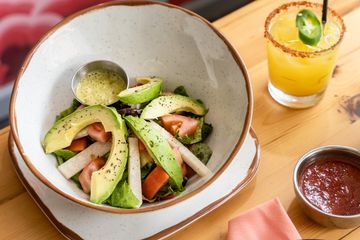Choose best mexican westchester NY cantinas for authentic cuisine
Wiki Article
Why Mexican Cuisine Is Famous: Checking Out the Cultural Relevance Behind the Dishes
Mexican cuisine sticks out for its lively flavors and deep social roots. The blend of spanish and indigenous impacts creates a distinct culinary identity. Each recipe narrates of practice, community, and party. Components like corn and chili peppers play essential functions fit these stories. To comprehend the full value of these culinary practices, one must check out the layers of background and significance that enrich every bite. What exists under the surface of this precious food?The Historical Roots of Mexican Food
Although Mexican food is commonly commemorated for its varied active ingredients and vivid flavors, its historic roots run deep, mirroring an abundant tapestry of social influences. Stemming from old Mesoamerican people, such as the Aztecs and Mayans, Mexican food developed via centuries of agricultural techniques that integrated regional crops like maize, beans, and chili peppers. The arrival of Spanish colonizers in the 16th century introduced brand-new active ingredients, including pork, rice, and milk, which integrated native traditions to develop special culinary fusions. This mix of influences not just formed the meals but also represented the social and social dynamics of the moment. Over the years, local variations emerged, affected by location, environment, and neighborhood custom-mades. As a result, Mexican cuisine stands as a reflection of its historical trip, embodying the resilience and flexibility of its people while celebrating their heritage with food.Regional Variety and Its Effect on Flavors
Regional variety plays a necessary duty fit the tastes of Mexican food, with each area adding one-of-a-kind active ingredients based upon regional agriculture and practice. Standard cooking methods better improve these flavors, mirroring the customizeds and backgrounds of individuals. Furthermore, the differing climates throughout Mexico influence which components thrive, causing unique local recipes that celebrate the country's cooking richness.
One-of-a-kind Active Ingredients by Area
Mexican food showcases an impressive array of one-of-a-kind active ingredients that vary substantially across its varied areas, each contributing unique flavors and culinary strategies. In the coastal locations, seafood such as shrimp and fish are staples, usually combined with exotic fruits like mango and coconut. The central highlands are recognized for their abundant variety of beans, corn, and squash, forming the basis of numerous standard meals. In the Yucatán Peninsula, achiote and sour oranges convey an unique flavor account, while the northern regions prefer beef and wheat-based recipes, showing the influence of surrounding cultures. Each area's climate and location form the neighborhood ingredients, developing a dynamic tapestry of flavors that highlight Mexico's rich culinary heritage.
Typical Cooking Techniques
The diverse ingredients located throughout Mexico not only form the meals however additionally influence the standard food preparation strategies utilized in each region. In Oaxaca, the usage of a stone mortar and pestle, understood as a "metate," is prevalent for grinding corn and flavors to create masa and mole. On the other hand, coastal areas typically make use of barbecuing and steaming approaches to prepare seafood, showing their access to fresh catch. The highlands may highlight slow-cooking techniques, such as barbacoa, where meats are covered in maguey leaves and buried in the ground. Each technique is deeply rooted in the regional culture, showcasing the importance of custom while enhancing the distinctive flavors that define Mexican food across diverse landscapes.Environment's Taste Impact
Although climate differs considerably throughout Mexico, it plays an essential duty in forming the tastes and active ingredients that define the nation's cuisine. Different areas experience distinctive weather condition patterns, affecting the agricultural outcome and cooking techniques. For example, the dry north is known for its hearty meats, while the rich south deals an abundance of exotic fruits and vegetables. Coastal areas take advantage of fresh fish and shellfish, which becomes a staple in their meals. Additionally, the highlands generate one-of-a-kind natural herbs and flavors that add to local specialties. This weather diversity not only improves the taste profiles of Mexican food however also mirrors the cultural identification of each area, showcasing the deep connection in between the environment and cooking heritage.The Role of Ingredients in Culinary Identification
Important to recognizing cooking identity, the components of a food reveal deep historic narratives and social connections. In Mexican cuisine, staples such as corn, beans, and chili peppers serve not only as fundamental components however additionally as icons of strength and adjustment. Corn, for example, is spiritual, reflecting its importance to agricultural techniques and indigenous cultures. The selection of beans showcases the country's biodiversity, while chili peppers include depth and heat, representing local variants and cooking imagination.These active ingredients are intertwined with rituals, customs, and regional customizeds, highlighting the value of location fit culinary identification. The integration of natural herbs like cilantro and spices such as cumin more enhances the taste account, demonstrating the impact of both indigenous methods and colonial histories. Collectively, these elements develop a dynamic tapestry that mirrors the intricacies of Mexican society, making its cuisine a powerful expression of identification and heritage.
Typical Food Preparation Methods and Their Significance
Conventional food preparation strategies in Mexican food work as an essential web link to the nation's heritage, protecting old approaches passed down with generations. These methods not only show regional variety however also enhance the one-of-a-kind tastes that specify the cuisine. Comprehending their importance reveals the social splendor embedded in every meal.Old Approaches Preserving Heritage
While modern-day culinary methods have changed the landscape of Mexican food, old techniques stay a necessary link to the country's abundant heritage. Strategies such as nixtamalization, the procedure of dealing with corn with lime to boost its nutritional value, have actually been essential fit typical dishes. Using clay pots and stone mortars, called molcajetes, also shows the emphasis on authenticity and taste that has actually been given through generations. These methods not only preserve the stability of ingredients but likewise embody public worths and social techniques. By continuing to utilize these ancient methods, contemporary Mexican cooks maintain a connection to their forefathers, ensuring that the cookeries continue to be reflective and lively of the nation's diverse background.Regional Techniques and Flavors
As varied as its landscapes, Mexican cuisine is identified by a myriad of local techniques and flavors that mirror the special social influences and regional ingredients of each location. In Oaxaca, making use of the comal for food preparation tortillas shows a tradition passed down through generations, while the Yucatán area showcases the slow-cooking technique referred to as cochinita pibil, emphasizing marinated pork covered in banana leaves. Coastal locations highlight fish and shellfish preparations, with methods like ceviche showing spanish and indigenous impacts. Each area's unique flavors, such as the great smoky chipotle from Veracruz or the lively chilies from Puebla, add to a rich tapestry of flavors - hand crafted margarita. These typical techniques not just enhance culinary diversity however likewise serve as a representation of the strength and creative thinking of Mexican societyCelebrations and Festivities: Food as a Social Expression
Events and festivities in Mexico are commonly marked by a selection of vivid meals that mirror the country's abundant cultural heritage. Standard dishes, such as tamales during Día de los Muertos and pozole during Self-reliance Day, display regional ingredients and cooking techniques, signifying neighborhood and familial bonds. Food becomes a medium for storytelling, with each dish carrying historic importance and local identifications.In enhancement to the recipes themselves, the rituals surrounding cooking and usage play an essential duty in these events. Family members gather to create elaborate meals, fostering links and protecting practices passed down via generations. The common nature of these cooking techniques highlights the value of sharing food as an expression of love and unity. Via these joyful celebrations, Mexican food goes beyond simple nutrition, acting as a cultural emblem that commemorates heritage, spirituality, and the happiness of togetherness.
Global Influence and Acknowledgment of Mexican Gastronomy
How has Mexican gastronomy got such extensive recognition worldwide? The answer hinges on its lively tastes, varied active ingredients, and rich social heritage that reverberate globally. Recognized by UNESCO as an Abstract Social Heritage of Humankind, Mexican food showcases a special mix of spanish and indigenous impacts, making it unique and appealing.Restaurants focusing on Mexican recipes have actually multiplied globally, presenting genuine flavors such as mole, tacos, and tamales to varied tastes. The appeal of Mexican food has also been strengthened by celebrity cooks and food preparation programs, which highlight its cooking techniques and customs.
Food celebrations and social events commemorate Mexican gastronomy, further raising its standing on the globe stage. As an outcome, Mexican cuisine goes beyond borders, cultivating appreciation for its freshly made guacamole historic relevance and cooking artistry, ensuring its enduring impact in the worldwide cooking landscape.
Regularly Asked Inquiries
What Are the Health And Wellness Conveniences of Conventional Mexican Meals?
Typical Mexican meals offer numerous health advantages, including high fiber web content from veggies and vegetables, healthy and balanced fats from avocados, and necessary nutrients from seasonings. These components add to enhanced digestion, heart wellness, and overall wellness.
Just How Can I Recreate Authentic Mexican Recipes in the house?
To recreate genuine Mexican dishes in your home, one must resource fresh active ingredients, utilize standard food preparation techniques, discover regional variations, and adhere to reputable recipes while embracing the cultural nuances and vivid tastes inherent in Mexican food. (churros)What Duty Do Spices Play in Mexican Cooking?
Spices are essential in Mexican cooking, enhancing tastes and fragrances. They offer depth and complexity to recipes, mirroring local diversity. Common seasonings like chili, oregano, and cumin add to the vibrant, bold profiles characteristic of Mexican food.Are There Vegetarian or Vegan Options in Mexican Food?
Yes, Mexican food offers countless vegetarian and vegan alternatives. Recipes such as chiles rellenos, nopales, and various bean prep work display the abundant tastes and active ingredients readily available, making it obtainable for those following plant-based diet regimens.Just How Has Mexican Food Influenced Other Global Foods?
Mexican cuisine has greatly influenced global cuisines via the intro of ingredients like corn, beans, and chili peppers, inspiring fusion dishes and enhancing taste accounts in numerous culinary customs, especially in the United States and Latin America.Mexican cuisine stands out for its dynamic tastes and deep cultural origins. Mexican cuisine is commonly celebrated for its diverse components and lively tastes, its historical roots run deep, reflecting a rich tapestry of social influences. Regional variety plays a vital function in forming the flavors of Mexican cuisine, with each area adding one-of-a-kind ingredients based on regional agriculture and practice. Mexican food showcases a remarkable array of unique ingredients that vary considerably across its varied areas, each adding unique flavors and cooking methods. As diverse as its landscapes, Mexican food is defined by a myriad of local strategies and tastes that mirror the distinct social impacts and neighborhood active ingredients of each location.
Report this wiki page